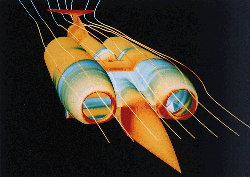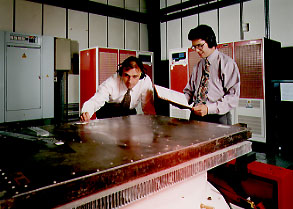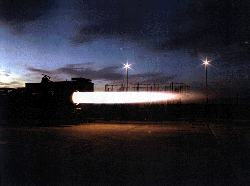
The land speed record is currently held by Richard Noble in Thrust 2 which achieved 633mph, or Mach 0.83, in 1983. The aim of Richard Noble's latest project, Thrust SSC, is to build a car capable not only of beating this record but of travelling faster than the speed of sound. The project is providing a focal point for a wide range of industrial sectors and is supported by more than 138 companies.
This article looks at the design of Thrust SSC and some of the work that has gone into the project so far. It then looks in more detail at the environmental testing carried out, by Fareham-based Assessment Services, and the follow-up testing carried out at the Directorate of Test and Evaluation's Aero-Engine Trials facility at Shoeburyness.
The main obstacle to travelling at over 750mph (Mach 1) is that, as it has never been done before, no information is available on supersonic ground effect. At the car's maximum speed of 850mph the dynamic pressure is ¾ tonne per square foot. To accurately recreate these conditions experimentally would require a wind tunnel with an 850mph conveyor-belt to represent the 'moving ground'. This is clearly out of the question.

The initial design was 'pencilled' by Ron Ayers, the project's chief aerodynamicist, based solely on his experience and knowledge of aeronautics. The flow around the initial design was studied using computational fluid dynamics (CFD). This CFD study was enormously complex and each case considered took 6 hours of computing on a CRAY 92 computer. The data proved that the initial design was viable and this was supported by tests performed on a scale model of the car. These tests involved 13 runs on a rocket sledge at speeds of up to 820mph and acceleration of 50G, whilst passing within one millimetre of a simulated ground surface. Readings from pressure sensors on the model correlated well with pressures predicted by the computer model. Although these results are very encouraging, more aerodynamic testing will have to be carried out on the finished car.
The safety of the driver is paramount and Thrust SSC is one of the most heavily instrumented cars ever built. There are 147 sensors on board, 30 with telemetry links to the support team. The main concern is that the nose may rise at high speed. This would lead to immediate and catastrophic failure. Various safety measures were considered to protect the driver in this event including ejection and fuel dumping, but both were found to be impractical.
Thrust SSC features the full range of passive safety measures, including a roll cage and driver restraints, but at 850mph these can only afford limited protection. Therefore Thrust SSC was constructed with the engineering requirement that it must remain on the ground at all times even when major system failure is occurring. To achieve this, Thrust SSC features a computerised nervous system with logical reflexes to any given situation. For instance, in the event of one engine failing, strain gauges will detect the sudden difference in thrust, and within milliseconds the thrust of the other engine will cut. The likelihood of an 850mph spin is therefore greatly reduced.
The answer to the nose lifting is to raise the tail-end of the car to create an aerodynamic down-load. This is achieved through Active Ride Suspension (ARS), using data from a sensor on the front suspension of the car that measures the downforce 500 times per second. Should the hydraulic system not have time to operate in the event of the nose lifting off, a responsive aerodynamic system has been developed, capable of applying three tonnes of extra downforce to the nose in only 10 milliseconds. This allows time for the tail to be lifted hydraulically, the engines to be shut off automatically, and a drag chute deployed to bring the car to a halt, even at 850mph. Five layers of fail-safe logic circuitry ensure that system failures will not result in the vehicle becoming airborne.
Structural failure has been protected against through safety factors of 2.5 to 4.0, 30 strain gauges, and load cells, to detect any problems before they become critical.
When the car is travelling at full speed, the wheels rotate at 8,500rpm. The radial acceleration at the rim is 35,000G, and so tyres are completely impractical. To cope with these enormous loads each wheel is an L27 aluminium forging weighing over 160kg, its contour being specified by computer to minimise stresses. No tyres are needed as the high speed runs will be made on the desert which will provide the 'yield' at the surface. Water-laid deserts are extremely flat and surprisingly good at load bearing. The carbon disc brakes (as big as those on a Boeing 757) are operated by fully duplicated hydraulic circuits.

However, failure due to vibration is the most likely scenario. This may be the result of ground-noise, trans-sonic buffeting, or acoustic noise from the engines. Consequently some practical testing is a necessity. Finite element analysis modelling has been carried out on the steel chassis structure and the entire car will be subjected to structural resonance testing.
The front third of Thrust SSC's bodywork is constructed from carbon fibre whilst the middle third is manufactured from rolled aluminium. The rear third, however, is designed differently as it must cope with the exhaust of the engines. The two Rolls-Royce Spey 205 turbo jet engines produce 100,000hp between them - the same output as three naval frigates, equivalent to 20 tonnes of thrust at 850mph. Temperatures at the rear body skin can reach more than 300�C, with sound levels of about 175dB. The panels adjacent to the exhausts are therefore constructed from titanium rather than aluminium.
It was these titanium panels that physicist Gillian Tracy asked Assessment Services to test, using the £1/3 million 'shaker' within the company's Environmental Test facility. The aim of the testing was to see if a representative panel section and its means of attachment would withstand the acoustic pressure created by the engine exhausts. The shaker was used as a piston to excite the air between the shaker and the panel and create 'artificial noise'. Panel vibration was measured by accelerometers attached to the panel. The strain placed on the rivets and bonding systems by the vibration was also examined, using photoelastic plates and polarized light.
The tests showed that the panel was well within its design limits, and that the means of fixing remained stress free, with little need for modification. With this in mind, testing moved to the Directorate of Test and Evaluation's Aero-Engine Trials facility at Shoeburyness. Here, the same panel section was bolted in place behind one of the Thrust engines mounted on a test rig. The panel was then subjected to five blasts of the engine on full reheat for 30 seconds at a time. Data was recorded using a laser vibrometer, as conventional accelerometers could not be securely attached. As the effect of the jet exhaust on the panel will be reduced by the forward movement of the car, these tests represented a 'worst case scenario'. The panel passed with flying colours, with the data correlating well with the laboratory tests conducted at Assessment Services.

At present, the panel has been tested in isolation, when in fact it forms one side of a box, with a jet engine on each side. There remains therefore the question of the panel's reaction to pressure acting on both sides. Because of the unique nature of Thrust, this sort of question can only answered by tie-down testing and low-speed test runs. Thrust SSC is due for completion in early March and test runs up to 250mph will be carried out. Test runs will be carried out at progressively higher speeds on a runway at a UK airfield, and if problems occur with the panels then the design will be modified as appropriate. Some work has already been carried out on several alternative designs, and should the need arise they would be put through the entire experimental test regime.
The Thrust SSC project represents the best of British design, engineering and test innovation, focused on the one goal of a supersonic land speed record. The culmination will take place on the Black Rock desert, Nevada, USA, possibly as early as Autumn 1996. However, before it becomes a record breaking car, Thrust SSC is a research vehicle. Progress will be dictated by safety considerations so it is not possible to predict a date for exceeding the speed of sound. In the meantime, the work continues.
Editorial contact:
Pete Rowe Dryden Brown Limited Building 2 Shamrock Quay Southampton SO14 5QL UK Tel: +44 (0)1703 229041 Fax: +44 (0)1703 227274 Email: dbl@cix.compulink.co.uk or attmail!dbl!pete
 |
 |
 |
||
| Sponsored by | This site best viewed with Microsoft Internet Explorer 3 | |||